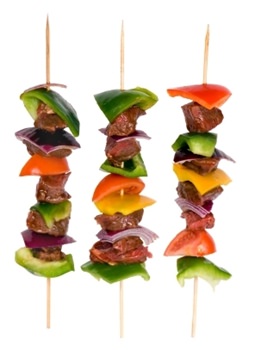I came across this post by Jeremiah Owyang. His comments resonated with me regarding what I too have noticed is the mis-use of micro-blog media - namely Twitter. Whereas Jeremiah sees it as over-using Twitter, becoming reliant on it, I wonder if it's a symptomatic content issue with sales promotion thinking being a big example. In that case Twitter is but the most recent channel to suffer mis-use.
Are you short serving your audience?
Jermiah comments "I’m seeing an unbalance in how individuals are trying to get the word out, and an excess focus on micro tools, resulting in some bad behaviours". It's a serious point because if so you only hurt your own brand as your audience will refuse your messages and content and go elsewhere.
What's causing this problem?
 Jeremiah calls it shish kebab in his analogy, essentially serving people short, low quality snippets as the primary method for sharing your messages, without adding in longer lasting or high impact content. He goes on, "Unlike Facebook's intelligent sorting of news items, Twitter is at risk as users are rewarded to publish frequently in order to stay top of mind." In recognition of the cultural shift in how media is consumed, have brands and individuals forgotten about long-form, quality content, or “steaks” as Jermiah calls them?
Jeremiah calls it shish kebab in his analogy, essentially serving people short, low quality snippets as the primary method for sharing your messages, without adding in longer lasting or high impact content. He goes on, "Unlike Facebook's intelligent sorting of news items, Twitter is at risk as users are rewarded to publish frequently in order to stay top of mind." In recognition of the cultural shift in how media is consumed, have brands and individuals forgotten about long-form, quality content, or “steaks” as Jermiah calls them?
Is it really about Twitter?
Isn't it a content, or "nutrition" problem using Jeremiah's analogy, rather than the tool. Of course, I accept Jeremiah's comment of publishing too much, yet I feel it's the quality of of what's served up that is more important, whether via a blog or micro-blog. After all how often do you see poor or repetitive blog posts, lame promotions in Facebook, rubbish corporate videos in You Tube - it still adds to the "noise"? Un-targeted communication is junk, the net effect is that throw away publishing (via email, Twitter or Facebook) en masse is interruptive and wasteful to everyone.
Email, still today, is abused because marketers that don't think about the audience first. I remember reading this post by Seth Godin years ago - he also posted this about friction saving the medium where he predicted similar things about Twitter.
How do you serve quality (steak or otherwise!) into your mix?
It is not about thinking of digital tools first! Behave like a thought leader, understand what people want and give it to them, here's a mix of Jeremiah's recommendations with a few of our own:
- A blog is your hub - or as Jeremiah calls it a "master archive" tool, where you can collect and share your thoughts with your audience. Blog content is easy to find for your users and is centralised, it's also part of your domain so isn't going to get lost. If you think blog first I also believe that you naturally think quality first and can flag more sources of information - you can be more useful and more findable. Monitor what content sparks the most sharing and interactions, your audience will highlight what they're most interested in - with both implied or explicit signals.
- Q&A sites and communities - play a social role, add value and then naturally leverage the benefits of participation. The key is to research where your market is first, are we talking Facebook, LinkedIn, Quora or an industry portal? It'll likely be several, of course. Think about what you can learn by monitoring discussions, where you can add value to discussions and join in where you can spark your own discussions. Any opportunity to add value to other people is the real key here, and those you help or are seen to help, might just become new customers or advocates.
- Serve a range of content types - and then share them in multiple, relevant places.
- Jeremiah makes a good point on infographics as a key way to convey meaningful data in short bites, they are easy to spread to blogs and Facebook. Though, I disagree it's instead of white papers as Jeremiah suggests, since some audiences appreciate thought leadership pieces like free papers, guides or ebooks. Infographic are extremely shareable and easy to consume - though doesn't that make them shish kebab!? Guess that's my point on content nutrition.
- Also, consider Slideshare or Scribd which we've found hugely useful for Smart Insights too, Jeremiah adds about launching content with Slideshare's embedded video zipcast [http://blog.slideshare.net/2011/02/17/10-ways-to-use-zipcast/] which is a great tip.
- Video and audio represent the hi-fi of content and engagement - as well as marketing that content off-site (You Tube, Vimeo and iTunes been the obvious outlets) we'd suggest creating a transcript to ensure they're findable in text search, maybe summarising them in a blog post for example.
At the end of the day, it's all about the mix - there is no right or wrong in terms of tools, there's only what works for you and that (rest assured) will keep evolving! What is guaranteed is that relevance through great content, offering something of value, is the key. It's the horse before the cart.
How are you finding getting the mix right, what's working for you and your brand?







